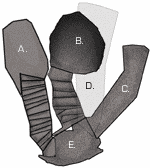
 |
 |
| Home |
| About Orkney |
| History |
| Tradition |
| Folklore |
| Placenames |
| Images |
| Downloads |
| About the Site |
| Contact |
| Links |
| Search Site |
| Awards |
| Minehowe - The Underground Enigma | |
A mystery reopened
In 1999, there was one archaeological site that turned all eyes to Orkney - Minehowe, a mysterious, underground structure, buried deep within a mound in Tankerness. Within days of the howe being reopened, by landowner, Douglas Paterson, the tale of the two-storey construction had made it to the national, and international, press - albeit with some fairly sensational additions. One such account hailed the chamber as a "druid's temple", while others went as far as to manufacture "an aura of evil" that, they claimed, had caused the site's original excavators "to flee in such terrified haste that they were forced to leave their tools behind". But there was one crucial point that practically all the reports got wrong. Minehowe was not a new discovery. The chamber was first opened in 1946, and was undoubtedly known about for some time before that. But this, and the fact that many folk in Tankerness were well aware of its existence, did nothing to dim the media attention. What is Minehowe?
Dating from the Iron Age, Minehowe is an underground, stone-built chamber, dug into a large, earthen mound. Access to the chamber is by a steep, ladder-like, staircase of narrow stone steps. The first flight of steps takes the visitor down to a narrow landing, from which two long, low chambers branch out at almost right angles. From here, like a spiral staircase, a second steep flight of steps leads down into the darkness until it reaches a sudden drop of about five feet into the lower chamber at the bottom of the structure. Approximately 20 feet from the top of the howe, this small chamber was thought to be a well by the 1946 excavators, who recorded that it had contained bones and ashes. But when it comes to the exact purpose of the structure, modern archaeologists remain puzzled. Although the experts who studied the chamber in 1946 emphatically labelled it a broch, we can now rule out that theory. When it comes to the role of Minehowe, it is generally agreed that the structure has a ritual or religious purpose - perhaps a symbolic entry to the underworld, or a place to commune with the spirits of the earth. Within the lower of the two "first floor" chambers was a broken hammer stone. Alongside was the skull of a small dog - a find that echoes the discovery of 24 dog skulls at the Cuween chambered cairn, outside Finstown. Was this skull left here for a reason? Perhaps guarding, or protecting, the entrance. The discovery added weight to idea that the structure had a ritual purpose.
Minehowe is surrounded by a massive ditch, similar to that surrounding the Ring o’ Brodgar in Stenness. The could imply that the enclosed are had been considered in some way special - the ditch perhaps marking a boundary between the sacred and common ground. "The Orkney Mystery of the 29 Steps" Aside from a second, intact, hammer stone, and the tools abandoned by the excavators, nothing else was left on site after the 1946 excavation work. Back then, The Orcadian newspaper, of August 29, 1946, christened the discovery "the mystery of the 29 steps" and told how the jubilant diggers brought back to the surface "stone axes, knives, hammers and a piece of clay urn." As well as the "hundreds of bones and other relics were strewn about the floor of this chamber", the report goes on to explain that also among the items found were "curious polished stones (fairly common in Orkney excavation), two teeth and some bones". Another hole revealed quantities of cockle shells, a find which convinced the excavators that they had to be working on an ancient dwelling. |
High Pasture Cave, an underground site in Skye, off the west coast of Scotland, is providing intriguing parallels to Minehowe. Click here for more details. The name Minehowe is probably a corruption of the site's original name "Moanhowe". "Moan" - pronounced something like "mow-in" is a common Orcadian placename deriving from the Old Norse "mó-inn" and means "the moor" or "the heath". Moanhowe, therefore, would be "the moor mound". |


